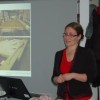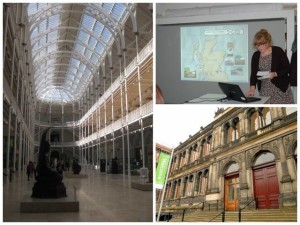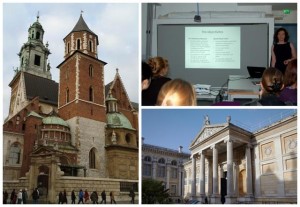
by Kate Clive-Powell and Jamie Robinson, first year students, MPhil Textile Conservation.
Last Monday we were taken on a whirlwind tour of conservation centres around the country and beyond courtesy of the second year MPhil Textile Conservation students back from their placement. This took the form of individual presentations and slide shows directed at some of the Textile Conservation Centre Foundation (TCCF) trustees, our tutors and us first years.

It was lovely to get a peek at what the second years had been up to over the summer. On hearing the presentations our initial thought was, ‘Wow – Will we really be at such an accomplished level next summer?’ It became apparent through the placement presentations that by the first summer of the course students are considered new professionals in the field of textile conservation. The variety of objects worked on was mind boggling and ranged from cleaning Vivien Leigh’s dress in preparation for re-display to investigating bark cloth brought to Britain by Captain Cook. Some information about Emma’s conservation adventures with bark cloth during her placement is available through the Pitt Rivers Blog.
The prospect of working within a professional studio is certainly a daunting task but each and every one of them seemed to take it in their stride. Emily was involved in emergency evacuation procedures at the Burrell Collection when large tapestries, approximately 8.5m x 5m, had to be quickly taken down. By contrast Alice talked of the challenges of working on a small scale during conservation of objects from a doll’s house at the V&A’s Museum of Childhood. It appears that there is far more to be learnt on placement than merely a consolidation of skills. A wonderful example of this was given by Alice and Melissa working at the V&A to a sharp deadline manically inflating the Michiko Koshino jacket in time for the ‘Club to Catwalk’ opening. A quite surreal experience no amount of classroom practice will prepare you for!
A number of students chose to split their time between two placements creating interesting comparisons between public and private studios, large and small institutions and country specific methods of working. The approach to dyeing fabric supports at Wawel Royal Castle in Krakow was certainly a revelation to Maria: we were very impressed with the great enthusiasm with which she threw herself into the task. The general consensus from these contrasts seemed to be that no two centres were the same. While many placements were run by professionals who had been TCC trained at some point or other, the working environment and the specific requirements of each object made each placement a totally unique experience bound by a common set of ethics.

Since the presentations Jamie has spent her time Googling conservation studios around the world and imagining where she might go six months down the line. Kate’s mind has also been racing with ideas. Before beginning the course she worked at The Welsh Quilt Centre which definitely gave her a taste for folk art, so perhaps The American Folk Art Museum in New York is calling…

